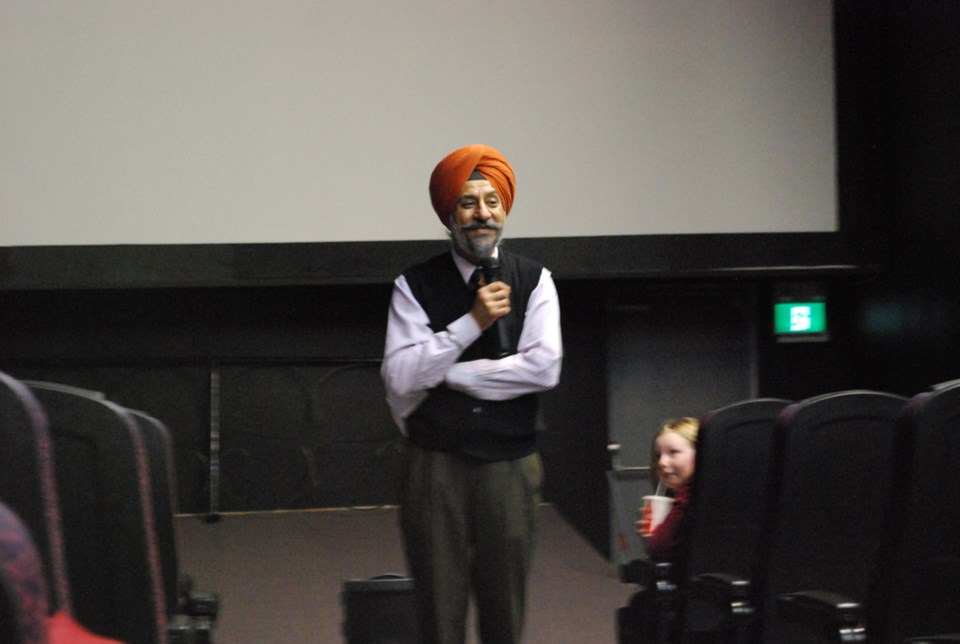Updated Mar. 24, 2016
It was the perfect day for discussing racism and racial identity.
Mar. 21 was the International Day for the Elimination of Racial Discrimination and the Humboldt Regional Newcomer Centre chose that day to hold their first tolerance movie event.
The day included the Humboldt Public School grade 7 and 8 classes in the morning including four teachers watching and discussing the movie, Bend it like Beckham.
A public showing in the evening opened up the discussion to the public and both showings had guest speakers, Jaswuant Singh and Fiseko Musonda both from Saskatoon there to discuss themes of the movie and answer questions about their cultures.
Singh saw a lot of things in the movie that he would consider “normal,” since he is Sikh, the same religion as the Bhamras in the movie.
He discussed different aspects of Sikhism after the movie was over, including their concept of Gurus and god.
Musonda was born in Saskatoon but moved around to many different countries as she grew up. Discussing her identity is not easy, says Musonda, who has lived/visited 11 different countries and over time has been exposed to and able to speak 9 different languages.
Being in an environment where they can ask questions produced a lot good questions, says the Newcomer staff.
The kids were mind-blown by Musonda’s stories about where she has lived and asked a lot of questions of Singh and Sikhism, including questions about his turban.
The movie had many great themes, especially the theme of respect for elders that both Musonda and Singh related to.
In her talk after the movie, Musonda says that in her cultural background, elders received the same level of respect whether the person was talking to an older family member or a street cleaner who happened to be older than them.
Moving around a lot, cultural identity was something she grappled with herself, just like the protagonist in the movie Jesminder.
“The issue of growing up and battling and trying to find out your own cultural identity because (your culture) is not 100 per cent your parents and it is not 100 per cent the ‘host country’ but it was a mix somewhere in the middle.”
The kids also had great questions on gender identity, gender roles, and generational differences.
“It was a good morning for the kids, I think they took a lot away from it,” says Executive Director, Janine Hart.
Hart says it was a good day to host an event like this because it fit the theme of the day.
Both Singh and Musonda says that eliminating racism is a misnomer because people think they have to eliminate differences in cultures.
Being identified as a visible minority is something that Singh wants to be recognized for but it is when people put judgements to that race where it causes a problem.
“It was also a systemic thing in a lot of anti-racism training a few years ago was to gloss over the difference...there is nothing wrong with being different,” says Musonda.
One teacher raised a good question, says Hart, about asking questions. Growing up in Humboldt, it was easier to just not ask questions, they said. This event created that space where people were free to ask the cultural questions without the awkwardness of thinking they are going to offend somebody.
Racial tolerance is something that Canada is very good at, says Singh. Not that there is not room for improvement but sometimes we fail to realize how good we are at tolerence, religious acceptance, and talking to each other.
“Many times we don’t appreciate it as much. If you compare Canadian people will all the other nations in the world...we are pretty good. Sometimes we fail to appreciate that.”
Cultural discovery and learning about other cultures is something that is so beneficial, says Musonda, because it creates diversity within someone’s life.
“Enjoying the diversity and just everything that it brings to it. It adds so much value to life.”
Musonda was very impressed with the centre’s proactive approach to this racial discussion. Starting this dialogue now, especially with young children, will frame how people see race in the future, especially as the children grow older.




